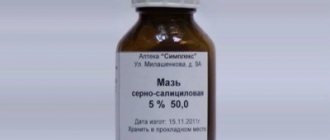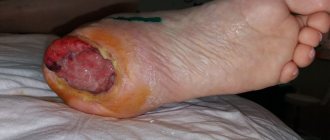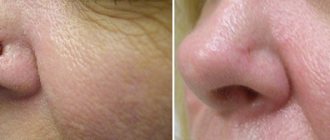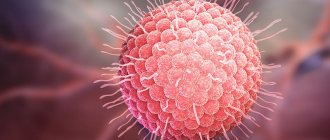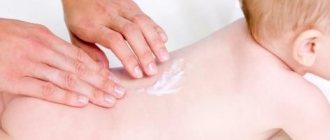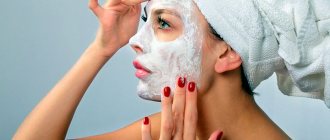Pink spot with white rim
The condition of the skin, like a mirror, reflects the general condition of the body.
Among the symptoms of many diseases there are all kinds of skin manifestations, and this allows you to notice the problem in time and cure it as quickly as possible. For example, if you have a spot on your skin with a red rim, then you must consult a dermatologist.
The fact is that this symptom is characteristic of a number of diseases that require different types of treatment, and the longer you delay a visit to the hospital, the more difficult it will be to eliminate the problem.
Possible reasons
A spot with a red rim that appears on the skin is a characteristic sign of disease, and in most cases, infection with some type of fungus is diagnosed.
Here are the most common causes of skin lesions in the form of spots with a pink or red edge:
- fungal;
- infectious and viral;
- allergic;
- endocrine and others.
It should be noted that the symptoms of the same disease may be stronger or weaker in different people. For example, psoriasis may begin as fairly pronounced spots with a clear border of a contrasting color, but it quickly acquires characteristic additional signs. The affected surface of the skin begins to peel off with mealy flakes, somewhat reminiscent of oatmeal.
Skin monitoring
If the reason for your visit to a dermatologist is a spot with a red rim that appears on the skin, you should carefully monitor the accompanying symptoms.
You may have noticed that new spots are appearing, the skin has begun to peel off, or existing marks are constantly enlarging, itching or changing color. What does the skin look like inside the spot, is there a depression or an inflamed, weeping surface there?
If a spot appears on the scalp, does the hair fall out? All these are important additions that will help make the correct diagnosis.
Fungal diseases
Fungal skin diseases are often called the general word “lichen,” but this is not entirely true.
For example, pityriasis rosea is an inflammatory disease presumably of viral origin, although the causative agent has not yet been identified, and its similarity with the same ringworm is very distant.
An inexperienced eye will not reveal any special differences, but fungal diseases are characterized by a clear boundary - a spot on the skin with a red rim, and the shape of the formations is round or oval.
Multicolored, ringworm, or lichen planus - all these diseases are caused by fungi. In most cases, doctors prescribe complex treatment that combines external agents in the form of ointments or sprays and systemic antifungal tablets. “Lamisil”, “Clotrimazole”, “Fluconazole” and similar products.
Why should you go to a dermatologist?
Visual self-diagnosis is quite unreliable; you can mislead yourself and begin long-term and hopeless treatment of symptoms. Sometimes you can accidentally guess, and then the treatment will work, but is it worth making a lottery out of your own health?
To diagnose fungal diseases, for example, a comprehensive examination of scrapings is carried out under a microscope, and the material is also checked in the rays of a fluorescent lamp with a Wood filter.
Yes, at first glance, a white spot with a red rim on the skin resembles some types of lichen; sometimes young psoriatic plaques look like this. But the final diagnosis and selection of medications must be made by a dermatologist.
Traditional medicine recipes
If you have a round spot on your skin with a red rim, in this case traditional medicine recommends using natural remedies. For ringworm, the spots are generously moistened with vodka infused with crushed garlic. In various combinations, alcohol and garlic are used to treat any skin manifestations.
Natural birch tar is included in many medicines. You can lubricate lichen plaques either with pure tar or in a mixture with egg white. The same remedy is used for weeping eczema, which is sometimes mistaken for lichen.
But nicotine tars from a smoker’s pipe, which are also called medicinal, can in fact only cause severe allergic complications. Resin received its reputation as a medicinal product solely because of its external resemblance to tar.
Allergies and autoimmune diseases
There are several other reasons that can cause a rash on the body in adults and children. With allergic irritation, large pink lesions appear. They usually have a pinkish color at first, then turn red, swell, and become covered with blisters filled with liquid. The person experiences severe itching, swelling of the respiratory tract and high fever may occur. Dermatitis can be triggered by new foods, medications, powder, soap and other similar products.
Autoimmune diseases (psoriasis or lupus erythematosus) are characterized by the appearance of pink spots on the patient’s body. These diseases are also accompanied by other symptoms. They should only be treated by a specialist so as not to cause deterioration.
Other reasons may be the person’s psycho-emotional state and lifestyle. Many people notice a white spot with a red rim on the skin after severe emotional shock, stress or fear. In this case, it is recommended to take sedatives and seek help from a specialist. An unhealthy diet with a lot of fatty, spicy and sweet foods affects the condition of the dermis. Sometimes rashes bother women on a strict diet, as they lack beneficial microelements.
Traditional pharmaceuticals
Photo: daisies
Skin inflammations, including dermatitis, were treated by folk healers using herbal remedies, tree oils and animal fats.
Let's look at how traditional medicine can cure dermatitis on the back:
Rubbing from a decoction of string, chamomile, celandine (1 teaspoon per 0.5 liter of boiling water).
Add a few drops of lemon juice and a spoonful of burdock oil to the broth. Cream from 1 gram pork fat (melt over low heat), 2 teaspoons of sea buckthorn oil. Mask of mashed potatoes and natural milk (heat to degrees). Apply warm for a minute, covering with film. Ointment made from tea tree oil and buckwheat honey. This ointment for dermatitis on the back is not contraindicated even for children, unless there is a personal intolerance to the ingredients.
Lotions of plantain, sage, rose hips (fruits), yarrow, starch (1 tsp).
Starch is added to the broth last. The product is not washed off later.
This disease can be quickly cured in both children and adults.
The main thing, in addition to pharmaceutical medications, is to provide the body with oxygen, optimal nutrition, and the correct regimen. It is better to cleanse the intestinal tract, liver, and kidneys from time to time.
Often the disease occurs due to an excess of toxins. If this is not done, then the healing will only give a temporary result.
Pharmaceuticals
Considering that many folk remedies have a strong odor or stain clothes, it makes sense to turn to pharmaceutical drugs specially designed against dermatological diseases. If the doctor has confirmed that a pink spot with a red rim on the skin is actually the result of a fungal infection, then it is better to give preference to antifungal agents.
Lamisil ointment or spray acts quite quickly and helps well against almost all types of lichen. Traditional Clotrimazole works better at the initial stage of the disease. If the situation is advanced, then systemic treatment is prescribed, when in parallel with external agents it is necessary to take antifungal drugs in tablets. In some cases, it is recommended to combine the use of Fluconazole or Clotrimazole with hepatoprotectors, which will reduce the risk of an inhibitory effect on the liver.
Red spots of an infectious nature are treated with antibiotics, and if they are caused by a virus, then antiviral drugs are prescribed for systemic use. Allergic reactions are primarily a symptom, so antihistamines that affect the very cause of the painful condition are a necessary, although not sufficient, remedy. First of all, you need to eliminate contact with the allergen. Finally, if an endocrine cause is found for a skin reaction, then it is necessary to treat the underlying cause rather than focusing on cosmetic problems.
In most cases, the appearance of spots on the skin with a red rim indicates the presence of a disease in a person. Most often we are talking about fungal infections and allergic reactions, less often their appearance can be caused by endocrine disorders
Much attention must be paid to the accompanying symptoms, which help, during an in-person examination, to determine the nature of the origin of spots on the body with a white or red rim. In doubtful cases, a microscopic examination may be prescribed and the lesions may be illuminated under the rays of a Wood's lamp
Types of stains with photos
For differential diagnosis of diseases, it is important to consider:
- localization and intensity of rashes;
- is there local itching, peeling;
- presence of local hyperthermia;
- condition of regional lymph nodes.
The following types of spots with a rim on the skin are distinguished::
A white spot with a red rim indicates low levels of melanin pigment. Such spots may be of a genetic nature or develop due to systemic disorders in the body.- Red with whitish borders is a symptom of allergic dermatitis or skin lesions.
- Pink with a red border occurs in a number of different diseases (mycoses, pseudomycosis, dermatitis).
Information for fashionistas who take care of their appearance: botox for hair, lamination, benefits and harms of procedures.
Flaky spots - dermatoses
Various dermatological pathologies manifest themselves on the skin as flaky spots. Some types of spots can be very itchy. As a rule, these are dry spots that have various shades - from pearlescent pink to bright red. They protrude above the surface of the skin and are called dermatological plaques.
Flaky, dry patches on the skin can be a sign of the following pathologies:
- pink lichen of Zhiber;
- herpes zoster;
- ringworm;
- psoriasis.
Some of these diseases are contagious, others result from immune pathology, or weakened immunity.
Pityriasis rosea
Appears as round pink spots on the skin. In the center they have a yellowish color, and around the perimeter they are surrounded by a peculiar border of a more saturated color. At first, a single plaque appears, and after some time there are many plaques. They peel off greatly, and a person may experience unbearable itching.
The disease occurs, as a rule, as a result of previous ENT diseases, and is seasonal in nature. Its peculiarity is that whether a person treats it or not, Zhiber’s lichen with rough spots on the skin will heal itself after a certain period of time. Read more about this disease and its treatment here.
Shingles
With this problem, a characteristic symptom is severe pain in the neck, lower back, legs and arms. This is a special condition that causes painful rashes that surround the ribs.
First, rough spots appear on the skin, which are very itchy and painful. The herpes virus, which lives in nerve cells, is to blame for their occurrence. Almost all people who had chickenpox in childhood have it. And at the moment when immunity is impaired, it makes itself felt
The rash becomes covered with blisters containing liquid that contains the active virus, so it is important not to let the blisters burst to prevent the virus from spreading further throughout the body.
Treatment consists of taking antiviral drugs and using local anesthetics. As a rule, during treatment the blisters dry up, the pain is relieved by various methods and the person recovers.
Ringworm
The cause of microsporia (ringworm) is anthropophilic parasitic fungi that can affect the scalp, nails, and skin. It is a contagious disease transmitted from person to person or from animal to person.
At the beginning of the disease, severe itching of the affected areas of the skin appears, after which small tubercles appear on it. Gradually, the tubercles become quite noticeable spots with a flaky crust.
If the spot appears on a hairy area of the skin, then in its area the hair begins to break off at the roots, and a kind of bald spot forms. Purulent blisters often form around the lesion, and a grayish coating can be seen at the ends of the falling hair.
Treatment of ringworm involves the use of topical antifungal drugs, which are prescribed by a dermatologist. In advanced situations, hormonal antifungal drugs taken orally are prescribed.
Psoriasis
The disease manifests itself by the appearance of dry spots on the skin, which tend to grow. Normally, a person constantly exfoliates the upper layers of the dermis, but with psoriasis this quality is lost. There is a gradual increase in dead layers of skin, and psoriatic plaques appear.
At the same time, the skin does not peel off, that is, it is not renewed. As the disease progresses, the number of dry spots increases, but they are not the only problem. Many of those affected suffer from psoriatic arthritis and eye disease. And if such plaques are removed, inflamed spots on the skin will be visible, which can become infected.
Psoriasis is a disease of the immune system that is treated with a set of measures, including exposure to ultraviolet light. A course of such treatment can sometimes reduce the manifestations of psoriasis to almost disappearance.
Possible diseases
Dermatology knows many diseases that provoke the appearance of spots on the body with a red border and pityriasis-like peeling. Most of them are of fungal origin; less often, such symptoms can be caused by allergies or chronic dermatoses. Here are the most common diseases with a typical clinical picture:
- Ringworm. A highly contagious fungal disease, most common in children aged 3-10 years. Most often, microsporia is caused by zoophilic M. canis and anthropophilic M. ferrugineum. In the first case, infection can occur after contact with an animal (usually kittens, less often dogs) or personal hygiene items of a sick person. Anthropophilic M. ferrugineum can only be infected through close contact with a sick person (most often these are children). Microsporia of the scalp is characterized by the appearance of spots on the skin with a red rim measuring 2-3 cm in diameter. Gray-white scales and mild erythema are most often visible inside the lesion. Another distinctive feature is hair that is broken off at the lesion at a height of 3-5 mm. Also, upon closer examination, you can see a gray-white coating around each hair. Upon microscopic examination, you can see the fungal spores that surround the hair. Microsporia of smooth skin is characterized by the appearance of multiple spots on the scalp, arms, neck, abdomen and legs. The size of the rash ranges from 0.5-2 cm. Clear boundaries are clearly visible. As the process progresses, the core becomes lighter, and small papular formations may appear inside. In some cases, several rings may form within the lesion. After washing, they quickly spread throughout the body. From subjective sensations there may be
- Dermatitis. In our case, we are talking about allergic contact and perioral dermatitis, which at the initial stage can appear as a spot on the skin with a red rim that does not itch or hurt. With perioral dermatitis, the rashes are localized in the mouth, cheeks, chin and nasolabial triangle. The size of the lesions is 2-5 cm. Contact dermatitis is characterized not only by the appearance of red spots on the body, but also by itchy blisters in the area of the lesions, which burst during the process, transforming into crusts. The most common locations are the hands, neck, abdomen and groin area.
- Athlete's foot. Another type of inguinal fungus, which appears as a large spot with a red rim in the area of the inguinal-femoral folds in men and women. Infection most often occurs in public showers, baths, swimming pools, etc. Also, inguinal athlete's foot is transmitted through close bodily contact and the use of personal hygiene items (towel, washcloth, etc.). It is more common in men aged 25-55 years. Predisposing factors are considered to be excessive sweating, excess weight problems and a chaotic lifestyle. Subjective sensations include itching of varying intensity and pain in areas of friction of skin folds. The surface of the lesions is rough to the touch, covered with scales and crusts. In every second case, peeling is observed. The course is long-term with periodic exacerbations in the hot season.
- Pityriasis rosea. Chronic dermatosis, which is common among people aged 20-40 years. The exact cause has not yet been established. The most likely causes are considered to be infections of bacterial and viral origin. The clinical picture includes the appearance of multiple spots on the skin with a red-pink rim up to 5 cm in size. The initial stage is characterized by the appearance of one lesion, which after 7-10 days begins to spread to other parts of the body. Color ranges from pale pink to orange. It is rough to the touch, as it is covered with small scales. The rash very often resembles a medallion in shape. A distinctive feature of pityriasis rosea is that in 90% of cases its appearance is not accompanied by any subjective sensations. Only in isolated cases do patients complain of slight itching.
- Psoriasis. At the initial stage, it can also appear in the form of red spots with a rim around the perimeter. But it quickly acquires its characteristic symptoms - the surface of the plaques is always dry with a floury peeling that resembles oatmeal. Localization of the rash is the scalp, hands, elbows, knees, back and stomach. Characterized by a long, relapsing course with periodic exacerbations after illness or stressful situations.
- Trichophytosis. Fungal skin infection, which is common in children aged 5-12 years. It has several forms, but we are interested in trichophytosis of the head and superficial. They are characterized by the appearance of one spot with a rim measuring 1-2 cm. Subsequently, the appearance of additional lesions and an increase in the size of the first spot, which will be several times larger than the newly appeared ones, are observed. Localization – scalp, open areas of the body (face, neck, torso) and hip area (buttocks, inner thighs). Another distinctive feature is hair breaking off near the lesions at a height of 1-2 mm above the skin level.
You can also remember about rubromycosis, which can manifest itself in the form of large brown spots in the groin area and large folds. Differential diagnosis is made with epidermomycosis.
Treatment of diseases causing spots on the body
Pharmacies sell a huge number of pharmaceuticals that help cope with skin pathologies. You should purchase medications only on the recommendation of a medical specialist. How to treat skin affected by spots with a red border?
- If spots with a red border are a symptom of a fungal infection, then it is necessary to use antifungal drugs.
- Most often, the antifungal agent Lamisil, available in the form of a spray and ointment, is used to treat affected skin. This medication acts quickly and destroys almost all types of pathogenic fungi.
- To eliminate redness and flaking of the skin, you can use Salicylic ointment. This external medication helps cope with many skin pathologies, has an antiseptic, anti-inflammatory, softening effect, and promotes the exfoliation of dead skin particles.
- You can also use Erythromycin ointment. It is a strong antibiotic that inhibits the ability of pathogenic bacteria to reproduce. For advanced skin lesions caused by a bacterial infection, doctors prescribe oral antibiotic medications.
To eliminate red circles on the skin caused by a viral infection, systemic antiviral medications are used. Removal of herpes zoster is carried out with antiviral tablets and ointments. The most commonly used drugs for treatment are Acyclovir and Valacyclovir. You can get rid of lichen planus through sedative medications.
Causes of the rash
At the initial stage, a small red spot with a white rim usually appears on the skin. It is often accompanied by itching, swelling, and peeling. In most cases, this is the first sign of a fungal infection, but allergies to medications, pollen, food, or any other agent can also manifest themselves this way. Problems of an autoimmune and endocrine nature also quite often manifest themselves as rashes in the form of spots on various parts of the skin of the human body.
Symptoms can be mild, moderate or severe. This point completely depends on the stage of the disease and the state of the immune system. Based on the main reasons for the appearance of spots, they can itch, increase in size, and peel off. They may develop a white or yellowish coating or begin to become wet. If the scalp is affected, yellow dandruff appears, hair either breaks off or falls out. The spots itch so much that the patient cannot get enough sleep at night, resulting in chronic fatigue syndrome and irritability.
Attention! At the first rash, it is important to note the condition of the rash itself and the presence of accompanying symptoms. This is necessary to make the correct diagnosis and select treatment.
When to go to the doctor
It is recommended to contact a specialist in all cases. If the spot goes away on its own without a trace, then perhaps the disease will not return. Making a diagnosis yourself is quite dangerous, since the disease can be contagious, which is fraught with consequences. If red spots with a white coating increase in size, itch, or are accompanied by other symptoms, then visiting a doctor is a must for recovery. You need to seek help from a dermatologist.
Sakania Luiza Ruslanovna
Dermatovenerologist, cosmetologist, trichologist
Ask a Question
At the appointment, the doctor will examine the affected areas and take a microscopic analysis of the scraping - it will help identify the presence of fungus and its type. The doctor will also examine the skin using a Wood's lamp; the lichen spots will be highlighted in a characteristic color. Additionally, a dermatologist may recommend consultation with other specialists to identify the exact cause of the disease. Sometimes it is difficult to make a diagnosis; some diseases have similar symptoms.
Treatment
Before you begin treatment on your own, you must consult a doctor. Only he will be able to correctly diagnose the disease and select adequate treatment.
At home, it is best to carry out preventive measures that will protect the body from various skin diseases. To do this, you need to lead an active lifestyle, minimize bad habits, consume more vitamins, and also take care of personal hygiene.
Autoimmune diseases differ in nature and must be treated differently. The main methods of treatment today are the anti-inflammatory system, as well as the use of drugs that can suppress the immune system.
The latter method works well in treatment, but exposes the person to great risks. The fact is that the body is greatly weakened and is therefore much more susceptible to severe infections. For proper treatment, constant monitoring by the attending physician is necessary.
Today, three main methods of treating this pathology have been developed:
- Gene correction;
- Antibody-based drugs;
- Medicines that regulate the functioning of the immune system.
As for the treatment of lichen, there is no special treatment. If itching is observed, a dermatologist can prescribe antihistamines, as well as various gels, in particular, sulfur-salicylic and sulfur-tar ointments. They not only relieve the symptoms of inflammation, but also allow you to quickly get rid of spots on the body.
Fungal infection can be treated with various gels, drugs that are taken orally and support the immune system, as well as with the help of folk remedies. Dermatologists note that ureaplast mycoplast, as well as batrafen, show their effectiveness well. These drugs come in the form of a gel, which is applied evenly over the entire affected area.
Reasons for formation
Round red spots on the skin can appear as a result of exposure to prolonged stressful situations and nervous shock. Their favorite localization is the face and chest; they usually disappear without a trace after a few hours.
But in the vast majority of cases, red round spots on the skin appear as a result of allergic reactions; most often they are diagnosed in children under 5 years of age. They can form as a result of:
- insect bites,
- taking certain medications,
- reactions to animal fur,
- consumption of certain foods,
- negative influence of cosmetics.
If the red circles on the skin itch, this again indicates an allergic reaction. In this case, you need to be very careful, because in severe cases, the pathological process may transition into Quincke's edema or anaphylactic shock.
There are also cases when round spots on the body appear after birth. They are usually called nevi; they can have a variety of colors. If the red round spot on the skin does not itch, then there should be no worries, but the best option would still be to consult a doctor.
White round spots on the skin may indicate vitligo. This pathological condition is not dangerous, but also requires consultation with a qualified specialist.
Spots on the body in the form of circles may indicate the formation of diseases such as:
- Ringworm. This is a fungal disease that is characterized by a round red patch on the skin that peels off. The most sensitive to this pathological condition are children aged 2 to 9 years. You can become infected after contact with a sick person or animal.
- Trichophytosis. This pathological condition also refers to fungal diseases. It manifests itself as the appearance of a large number of red spots on the skin or scalp, which are distinguished by blurred boundaries. The formation of this disease will be indicated by a red round spot on the leg, buttock, neck or face. The surface of the rash elements in this case will be covered with crusts. As for infection, it can occur as a result of using the same combs, hats and even bed linen with a sick person.
- Atopic dermatitis. This disease is most often diagnosed in children under seven years of age. The main feature of the rash elements is that they are pale pink in color and very itchy. In severe cases of the pathological condition, enlarged lymph nodes, fever and malaise may be observed.
- Discoid lupus erythematosus. This pathological condition is indicated by a red circle on the skin, the size of which is growing very quickly.
Before the appearance of such elements, the rash can be caused by hypothermia, exposure to the open sun for a long time, as well as mechanical injuries. Over time, the surface of the spots becomes covered with gray scales, the separation of which leads to pain. Favorite areas for localizing the pathological process are the chest, ears, neck and nasolabial triangle. However, the appearance of rash elements on the scalp, lips and oral mucosa is no exception.
Athlete's foot. This pathological condition is indicated by a red spot on the inner thigh or genitals. It can lead to discomfort in the form of itching. In severe advanced cases, large red spots are observed on the skin; their size can be as large as a plate.
You can become infected through skin-to-skin contact with a sick person or through personal hygiene items.
Psoriasis. At the initial stages of the formation of this disease, red-pink spots of various sizes appear. Over time, the elements of the rash may merge with each other, and gray scales appear on their surface. As for the causes of this disease, they have not been fully elucidated, but heredity and the influence of stressful situations play a significant role. These red round spots on the body do not itch and can be localized in any area, but most often it is the head, the flexor and extensor surfaces of the limbs and the lumbar area.
A red dense spot on the skin can also appear as a result of neurodermatitis or eczema. Similar elements of the rash may indicate sexually transmitted diseases, especially if they are localized in the genital area.
The main reasons for the appearance
- Mycoses, or fungal infections - a whole group of diseases caused by lower fungi. About 400 species of fungi are pathogenic for humans.
The incubation period ranges from 1 to 4 weeks after contact with a sick person or carrier of the pathogen. Pathogens pose a particular danger to persons with weakened immune systems and immunodeficiency states. Fungi can cause:- lichen;
erythrasma;
- athlete's foot;
- trichophytosis.
Pink . Predisposing factors for the occurrence of pityriasis rosea are chronic systemic diseases and weakened immunity. First, a small round spot with a bright rim appears on the skin, then it increases to 5–6 cm in diameter. The skin over the lesion is uneven, does not peel or itch.- Shingles . Its causative agent is not a fungus, but a herpes virus that causes chickenpox. The disease occurs with the formation of many small spots and blisters on their surface, which are very itchy. Gradually, the bubbles on the surface burst, liquid flows out of them, and then the spots become covered with a crust. Colds and hypothermia provoke the appearance of rashes.
- Red flat . The appearance of rashes in this case is possible not only on the skin, but also on the mucous membrane of the oral cavity and genital organs. Women over 40–50 years of age are especially susceptible to the disease. The rash gradually spreads to the torso, arms, and legs. With this pathology, the spots itch, but do not hurt and are not covered with scales; they look like wounds with a blood crust.
- Shearer . It affects children more often and affects the skin, hair and nails. The pathogen is transmitted from a sick animal or person to a healthy person through direct contact, as well as through dust and excrement. The elements of the rash become covered with scales, peel, and itch. When the scalp is damaged, hair falls out.
Allergy . During an allergic reaction, large lesions appear on the skin that are initially pinkish in color. Subsequently, the spots turn red, swell, and become covered with blisters filled with light liquid. The patient experiences severe itching. Allergic dermatitis can be triggered by medications, foods, detergents and many other factors.- Autoimmune processes. Autoimmune pathology (for example, psoriasis or systemic lupus erythematosus) is characterized not only by the appearance of pink spots with clearly defined boundaries on the patient’s body, but also by other symptoms. The main causes of autoimmune processes are:
- genetic predisposition;
hormonal disorders;
- emotional and physical stress;
- pathogens of infectious diseases.
- Poor nutrition. Eating large amounts of sweet, fatty, spicy foods, as well as a strict diet does not affect the condition of the skin in the most favorable way.
There are several types of lichen:
Erythrasma - infection of diaper rash by microbes, more often appears in people who neglect the rules of personal hygiene, living in hot climates, and suffering from diabetes.
Erythrasma looks like a swollen pink spot in the groin, armpit area, or under the breast. A distinctive feature is the periodic subsidence of clinical manifestations and the reappearance of symptoms. Athlete's foot can be contracted through direct contact with an infected person, as well as when visiting a public bath or sauna. With this disease, large, very itchy red spots appear on the chest, lower extremities, genitals, and armpits. Obese patients with excessive sweating are most susceptible to athlete's foot.
Trichophytosis is most often diagnosed in children under 12 years of age. The disease begins with the appearance of a small spot with a rim that itches and flakes. If treatment is not started in a timely manner, the process spreads to the entire body.
In people with psoriasis, plaques appear with clearly defined reddish edges , the middle peels off, falls off over time, and an itchy pale spot with a pink edge is formed. With systemic lupus erythematosus, in addition to rashes, weakness, apathy, increased fatigue, and muscle soreness are noted.
Important! If a spot appears on the skin, persists for several days, increases in size, changes color, be attentive to the accompanying symptoms: general malaise, fever, itching.
You should also keep an eye on moles on your body . They are formed from cells growing between the layers of skin - the epidermis and dermis. A white spot may appear around the mole, which sometimes indicates the transformation of the mole into melanoma. To clarify the situation, you should consult a dermatologist and conduct the necessary examinations.
Hair care products: masks, shampoos, coloring. A specialist will talk about spots on the skin with a rim in the video:
Categories
AllergistAnesthesiologist-resuscitatorVenereologistGastroenterologistHematologistGeneticGynecologistHomeopathDermatologistPediatric gynecologistPediatric neurologistPediatric urologistPediatric surgeonPediatric endocrinologistNutrologistImmunologistInfectious disease specialistCardiologistCosmetologistSpeech therapistElorologistMammologistMedical lawyerNarcologistNeurologistNeurosurgeon NephrologistNutriciologistOncologistOncourologistOrthopedist-traumatologistOphthalmologistPediatricianPlastic surgeonProctologistPsychiatristPsychologistPulmonologistRheumatologistRadiologistSexologist-AndrologistDentistTherapistTrichologistUrologistPharmacistPhytotherapistPhlebologistSurgeonEndocrinologist
